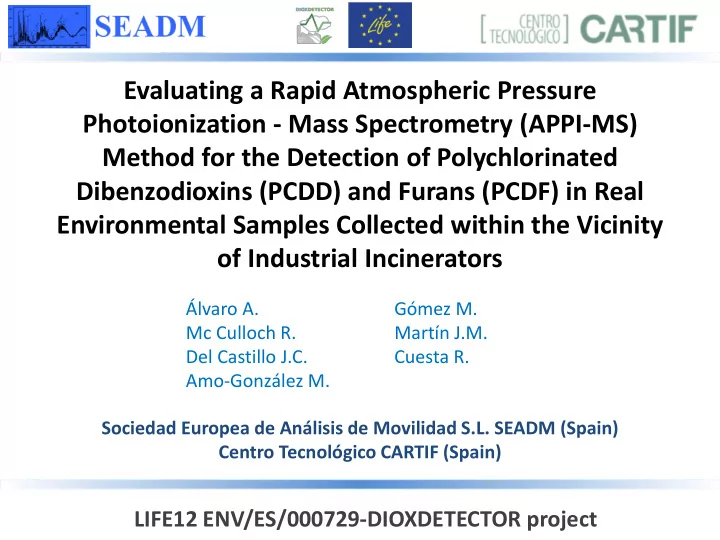

Evaluating a Rapid Atmospheric Pressure Photoionization - Mass Spectrometry (APPI-MS) Method for the Detection of Polychlorinated Dibenzodioxins (PCDD) and Furans (PCDF) in Real Environmental Samples Collected within the Vicinity of Industrial Incinerators Álvaro A. Gómez M. Mc Culloch R. Martín J.M. Del Castillo J.C. Cuesta R. Amo-González M. Sociedad Europea de Análisis de Movilidad S.L. SEADM (Spain) Centro Tecnológico CARTIF (Spain) LIFE12 ENV/ES/000729-DIOXDETECTOR project
Project Objective Application of a new analytical technique for the quantification of dioxin, tracking continuous PCDDs/PCDFs concentrations in air, soil and biota (vegetable matter) in the surroundings of a municipal solid waste incineration facility.
Project Outline • Identification of the sampling area • Sampling collection and sample preparation • Analyzer Definition • APPI Ionization • PCDD/F Limit of Detection • Analysis Results • Conclusions • Future actions • Acknowledgements
Identification of the sampling areas SURFER Output data: ADMS Input data: • The model estimates immission concentrations • Type and characteristics of the in the long term or short term emission source • • Dioxin dispersion map showing the most Position coordinates of the source • affected areas Meteorological data in the area of study • Two sampling areas were defined with two sampling points for each sampling area
Sampling collection and sample preparation • Air, soil and vegetable matter samples were taken monthly during a year at the four sampling points. Air ≈ 700 m 3 Soil ≈ 5 grams Vegetable matter ≈ 20 grams • PCDD/F extraction, clean-up and concentration were carried out according to the norm UNE-EN 1948-2.
Analyzer definition: PCCD/PCDF isomer separation by ion mobility DMA resolution was not adequate for isomer separation. A high resolution DMA is being developed by SEADM, but for the time being the DMA is not incorporated into the Analyzer:
Architecture of the APPI-MS analyzer SEADM ´ s Custom Sciex ´ s Qtrap 3200 APPI ion Source Triple Quadrupole MS
APPI Ionization • SEADM ´ s ESI/SESI Sources are ideal for polars, but not suitable for non-polars. • SEADM ´ s APCI Source is suitable for non-polars, but did not have enough sensitivity . • A new APPI Source has been developed with high ionization efficiency for both polar and non-polar compounds.
Analysis • Samples dissolved in toluene solvent infused into the nebulizer at 2µL/min • Sample is vaporized in the nebulizer at 400⁰C using 99.999% N 2 as nebulizer gas • PCDD/PCDF ionization: [M-Cl+O] - • Ions are transmitted to the MS using electric fields and analyzed in negative Multiple Reaction Monitoring mode.
PCDD/F Limit of Detection • Analysis of air sampled blanks and air samples loaded with liquid standards Log scale • LODs ranging from 0.15 to 1.40 pg; Homologues detected with a LOD around 1 pg • Method used for comparison purposes: NDAMN 1 - (HR-GC-MS) 1) The National Dioxin Air Monitoring Network (NDAMN) – Report of the Results of Atmospheric Measurements of Polychlorinated Dibenzo-p-Dioxins (PCDDs), Polychlorinated Dibenzofurans (PCDFs) and Dioxin-Like-Polychlorinated Biphenyls (PCBs) in Rural and Remote areas of the United States from June 1998 through November 2004.
Results of the Analysis – Location nº2 • The results correspond to the concentration of each homologue group. • Since isomers were not separated, no Toxicity Equivalence Factor was applied to the results. Blue – January, Red – February, Green - March
Conclusions • The APPI-MS/MS analyzer developed allows detection limits around 1 pg for each PCDD/F homologue. • Operational costs of the analyzer are considerably lower than present techniques: Cost per analysis ≈ 25 Euros. • According to project plan, the Analyzer will be improved at the end of 2016 with a high resolution DMA, which will allow isomer separation.
Future actions to improve the Analyzer: Ion Mobility Mass Spectrometry THA+ Mobility Peak acquired in SEADM´s high resolution DMA P5 Electrometer Voltage (V) 1.0 FWHM Resolving 0.8 Power = 115 0.6 0.4 0.2 0.0 5400 5500 5600 DMA Voltage (V) Isomer separation using SEADM´s High Resolution DMA will be possible allowing analysis in a few seconds. Since the DMA significantly reduces the chemical background it is expected an improvement in the LOD of the Analyzer
Acknowledgements • LIFE+ Program (LIFE12 ENV/ES/000729-DIOXDETECTOR project) • SEADM • CARTIF You can follow the progress of the project and the final results by visiting the project website: http://www.dioxdetector.eu - Thank you for your attention-
Recommend
More recommend